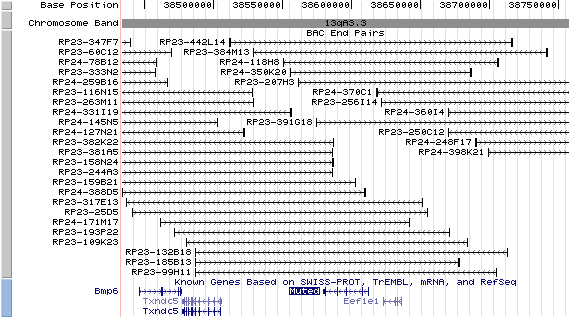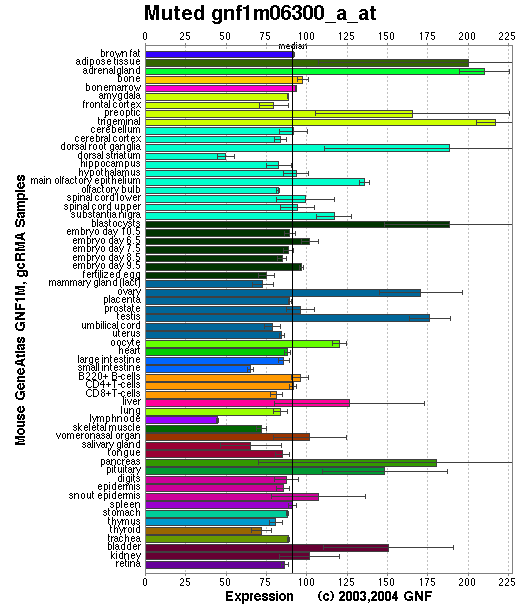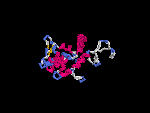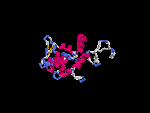GENOMIC
Mapping
13pA3.3. View the map and BAC contig (data from UCSC genome browser).

Structure
(assembly 10/03)
Isoform a (NM_139063): 5 exons, 32,403bp, Chr13: 38,579,419-38,611,821.
Isoform b (NM_178054): 5 exons, 23,228bp, Chr13: 38,588,546-38,611,773.
The C-termini are different between isoform (a) and (b) because of alternative 3' exons.
The figure below shows the structures of the known isoforms (data from UCSC genome browser).

Regulatory Element
Search the 5'UTR and 1kb upstream regions (human and mouse) by CONREAL with 80% Position Weight Matrices (PWMs) threshold (view results here).
TRANSCRIPT
RefSeq/ORF
a) Transcript variant 1 (NM_139063),
1,791bp, view ORF and the alignment to genomic.
b) Transcript variant 2 (NM_178054),
612 bp, view ORF and the alignment to genomic.
Expression Pattern
Tissue specificity: widely expressed with the highest levels in gall bladder, small intestine, and testis, but ralative lower amounts in skeletal muscle. A ~1.8kb band is present on PolyA+ northern blots (Zhang, et al).
Affymetrix microarray expression pattern in SymAtlas from GNF is shown below.

PROTEIN
Sequence
(Muted protein)
Isoform a (NP_620702): 185aa, ExPaSy NiceProt view of Swiss-Prot:Q8R015.
Isoform b (NP_835155): 169aa.
Ortholog
| Species | Human | Chimp | Chicken | Rat | FuguFish |
| GeneView | MUTED | 17708 | 012782 | LOC306868 | 156809 |
| Protein | NP_958437 (187aa) | 30229 (187aa) | 20823 (196aa) | XP_225255 (187aa) | 177063 (139aa) |
| Identities | 76%/143aa | 76%/143aa | 55%/109aa | 87%/164aa | 44%/65aa |
View multiple sequence alignment (PDF file) by ClustalW and GeneDoc.
Domain
(1) Domains predicted by SMART:
a) coiled coil: 156 - 184.
(2) Transmembrane domains predicted by SOSUI: None.
Motif/Site
(1) Predicted results by ScanProsite:
a) Amidation site : [occurs frequently]
17 - 20: gGKK.
b) cAMP- and cGMP-dependent protein kinase phosphorylation site : [occurs frequently]
20 - 23: KRdS.
c) N-myristoylation site : [occurs frequently]
25 - 30: GTpgAA,
99 - 104: GLgeTL.
d) Casein kinase II phosphorylation site : [occurs frequently]
51 - 54: TqgE,
80 - 83: TiqE,
133 - 136: TasE.
e) N-glycosylation site : [occurs frequently]
111 - 114: NDSI
f) Protein kinase C phosphorylation site : [occurs frequently]
135 - 137: SeK.
g) Bipartite nuclear targeting sequence : [occurs frequently]
124 - 140:
RKkvindyltasekrrl,
125 - 141:
KKvindyltasekrrlv.
(2) Predicted results of subprograms by PSORT II:
a) N-terminal signal peptide: none
b) KDEL ER retention motif in the C-terminus: none
c) ER membrane retention signals: found KKXX-like motif in C-terminus, KFST
d) VAC possible vacuolar targeting motif: found KLPI at 815
e) Actinin-type actin-binding motif: type 1: none; type 2: none
f) Prenylation motif: none
g) memYQRL transport motif from cell surface to Golgi: none
h) Tyrosines in the tail: too long of a tail
i) Dileucine motif in the tail: None.
3D Model
(1) ModBase No entry found.
(2) 3D models predicted by SPARKS (fold recognition) below. View the models by PDB2MGIF.


2D-PAGE
This protein does not exist in the current release of SWISS-2DPAGE.
Computed theoretical MW=21,283Da, pI=6.92 (NP_620702, isoform a).
Computed theoretical MW=18,770Da, pI=6.44 (NP_835155, isoform b).
FUNCTION
Ontology
(1) Process: pigmentation, vesicle-mediated transport.
(2) Protein interaction in BLOC-1.
Location
Cytoplasmic.
Interaction
Interacts with pallidin, cno, dysbindin, and Blos2 (Ciciotte, et al; Li, et al (2004); Starcevic, et al). The muted protein is a subunit of the biogenesis of lysosome-related organelles complex 1 (BLOC-1), in which it interacts with the products of seven other HPS genes, sdy, pa, cno, rp, Snapap, Blos1, Blos2 (Ciciotte, et al; Falcon-Perez , et al; Li, et al (2003); Moriyama, et al; Starcevic, et al) (view diagram of BLOC-1 complex here).
Pathway
Involved in the development of lysosome-related organelles, such as melanosomes and platelet-dense granules (view diagram of BLOC-1 pathway here).
MUTATION
Allele or SNP
2 phenotypic alleles is described in MGI:2178598.
Distribution
| Location | Genomic | cDNA | Protein | Type | Strain | Reference |
| Exon 1 | 60Gdel | 60Gdel | K20delG | frame-shift, 59X | mu (CHMU/Le) | Zhang, et al |
| Intron 3 | +2362A insEtn, 2357G~2362Adup | 319Tins 183bp | L107ins 183bp | in-frame | mu-J (T18H) | Zhang, et al |
Effect
A very small quantity of a larger band (2.0kb in mu/mu vs. 1.8kb in wildtype) is present on PolyA+ Northern blot (Zhang, et al ). Rare or no band was observed on the Western blots. The mutation does affect the stability of other subunits such as dysbindin and pallidin of BLOC-1 complex (Li, et al (2003)).
PHENOTYPE
Mutation in the Muted gene is the cause of muted mutant (Zhang, et al), a mouse model of Hermansky-Pudlak syndrome (OMIM 607289). The mu allele arose from CHMU/Le ch+/+mu. The mutant is described in more detail in JAX Mice database (B6.C3-Mutedmu/J). The muJ mutation occurred spontaneously on the T18H stock. The mutants present pigment dilution, prolonged bleeding time, and inner ear abnormalities, modeling Hermansky-Pudlak Syndrome (Swank, et al). Total numbers of melanosomes are reduced severely within the retinal pigment epithelium (RPE) and significantly reduced within choroids (Zhang, et al). The phenotype is described in more detail in Mouse Locus Catalog#Muted.
REFERENCE
- Ciciotte SL, Gwynn B, Moriyama K, Huizing M, Gahl WA, Bonifacino JS, Peters LL. Cappuccino, a mouse model of Hermansky-Pudlak syndrome, encodes a novel protein that is part of the pallidin-muted complex (BLOC-1). Blood 2003; 101: 4402-7. PMID: 12576321
- Falcon-Perez JM, Starcevic M, Gautam R, Dell'Angelica EC. BLOC-1, a novel complex containing the pallidin and muted proteins involved in the biogenesis of melanosomes and platelet-dense granules. J Biol Chem 2002; 277: 28191-9. PMID: 12019270
- Li W, Rusiniak ME, Chintala S, Gautam R, Novak EK, Swank RT. Murine Hermansky-Pudlak syndrome genes: regulators of lysosome-related organelles. Bioessays 2004; 26: 616-28. PMID: 15170859
- Li W, Zhang Q, Oiso N, Novak EK, Gautam R, O'Brien EP, Tinsley CL, Blake DJ, Spritz RA, Copeland NG, Jenkins NA, Amato D, Roe BA, Starcevic M, Dell'Angelica EC, Elliott RW, Mishra V, Kingsmore SF, Paylor RE, Swank RT. Hermansky-Pudlak syndrome type 7 (HPS-7) results from mutant dysbindin, a member of the biogenesis of lysosome-related organelles complex 1 (BLOC-1). Nat Genet 2003; 35: 84-9. PMID: 12923531
- Moriyama K, Bonifacino JS. Pallidin is a component of a multi-protein complex involved in the biogenesis of lysosome-related organelles. Traffic 2002; 3: 666-77. PMID: 12191018
- Starcevic M, Dell'Angelica EC. Identification of snapin and three novel proteins (BLOS1, BLOS2, and BLOS3/reduced pigmentation) as subunits of biogenesis of lysosome-related organelles complex-1 (BLOC-1). J Biol Chem 2004; 279: 28393-401. PMID: 15102850
- Swank RT, Reddington M, Howlett O, Novak EK. Platelet storage pool deficiency associated with inherited abnormalities of the inner ear in the mouse pigment mutants muted and mocha. Blood 1991; 78: 2036-44. PMID: 1912584
- Zhang Q, Li W, Novak EK, Karim A, Mishra VS, Kingsmore SF, Roe BA, Suzuki T, Swank RT. The gene for the muted (mu) mouse, a model for Hermansky-Pudlak syndrome, defines a novel protein which regulates vesicle trafficking. Hum Mol Genet 2002; 11: 697-706. PMID: 11912185
EDIT HISTORY:
Created by Wei Li & Jonathan Bourne 06/28/2004